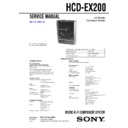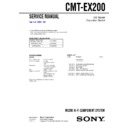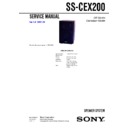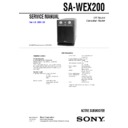Sony CMT-EX200 / HCD-EX200 Service Manual ▷ View online
2
HCD-EX200
SAFETY CHECK-OUT
After correcting the original service problem, perform the follow-
ing safety checks before releasing the set to the customer:
Check the antenna terminals, metal trim, “metallized” knobs, screws,
and all other exposed metal parts for AC leakage. Check leakage as
described below.
ing safety checks before releasing the set to the customer:
Check the antenna terminals, metal trim, “metallized” knobs, screws,
and all other exposed metal parts for AC leakage. Check leakage as
described below.
LEAKAGE
The AC leakage from any exposed metal part to earth Ground and
from all exposed metal parts to any exposed metal part having a
return to chassis, must not exceed 0.5 mA (500 microampers). Leak-
age current can be measured by any one of three methods.
1. A commercial leakage tester, such as the Simpson 229 or RCA
The AC leakage from any exposed metal part to earth Ground and
from all exposed metal parts to any exposed metal part having a
return to chassis, must not exceed 0.5 mA (500 microampers). Leak-
age current can be measured by any one of three methods.
1. A commercial leakage tester, such as the Simpson 229 or RCA
WT-540A. Follow the manufacturers’ instructions to use these
instruments.
instruments.
2. A battery-operated AC milliammeter. The Data Precision 245
digital multimeter is suitable for this job.
3. Measuring the voltage drop across a resistor by means of a VOM
or battery-operated AC voltmeter. The “limit” indication is 0.75
V, so analog meters must have an accurate low-voltage scale.
The Simpson 250 and Sanwa SH-63Trd are examples of a pas-
sive VOM that is suitable. Nearly all battery operated digital
multimeters that have a 2V AC range are suitable. (See Fig. A)
V, so analog meters must have an accurate low-voltage scale.
The Simpson 250 and Sanwa SH-63Trd are examples of a pas-
sive VOM that is suitable. Nearly all battery operated digital
multimeters that have a 2V AC range are suitable. (See Fig. A)
Fig. A. Using an AC voltmeter to check AC leakage.
0.15
µF
To Exposed Metal
Parts on Set
Parts on Set
1.5k
Ω
AC
voltmeter
(0.75V)
voltmeter
(0.75V)
Earth Ground
SAFETY-RELATED COMPONENT WARNING !!
COMPONENTS IDENTIFIED BY MARK
! OR DOTTED LINE
WITH MARK
! ON THE SCHEMATIC DIAGRAMS AND IN
THE PARTS LIST ARE CRITICAL TO SAFE OPERATION.
REPLACE THESE COMPONENTS WITH SONY PARTS
WHOSE PART NUMBERS APPEAR AS SHOWN IN THIS
MANUAL OR IN SUPPLEMENTS PUBLISHED BY SONY.
CAUTION
Use of controls or adjustments or performance of procedures
other than those specified herein may result in hazardous ra-
diation exposure.
other than those specified herein may result in hazardous ra-
diation exposure.
Notes on chip component replacement
• Never reuse a disconnected chip component.
• Notice that the minus side of a tantalum capacitor may be
• Never reuse a disconnected chip component.
• Notice that the minus side of a tantalum capacitor may be
damaged by heat.
Flexible Circuit Board Repairing
• Keep the temperature of soldering iron around 270˚C
• Keep the temperature of soldering iron around 270˚C
during repairing.
• Do not touch the soldering iron on the same conductor of the
circuit board (within 3 times).
• Be careful not to apply force on the conductor when soldering
or unsoldering.
ATTENTION AU COMPOSANT AYANT RAPPORT
À LA SÉCURITÉ!!
LES COMPOSANTS IDENTIFIÉS PAR UNE MARQUE
! SUR
LES DIAGRAMMES SCHÉMATIQUES ET LA LISTE DES
PIÈCES SONT CRITIQUES POUR LA SÉCURITÉ DE
FONCTIONNEMENT. NE REMPLACER CES COMPOSANTS
QUE PAR DES PIÈCES SONY DONT LES NUMÉROS
SONT DONNÉS DANS CE MANUEL OU DANS LES
SUPPLÉMENTS PUBLIÉS PAR SONY.
3
HCD-EX200
NOTES ON HANDLING THE OPTICAL PICK-UP BLOCK
OR BASE UNIT
OR BASE UNIT
The laser diode in the optical pick-up block may suffer electrostatic
break-down because of the potential difference generated by the
charged electrostatic load, etc. on clothing and the human body.
During repair, pay attention to electrostatic break-down and also
use the procedure in the printed matter which is included in the
repair parts.
The flexible board is easily damaged and should be handled with
care.
break-down because of the potential difference generated by the
charged electrostatic load, etc. on clothing and the human body.
During repair, pay attention to electrostatic break-down and also
use the procedure in the printed matter which is included in the
repair parts.
The flexible board is easily damaged and should be handled with
care.
NOTES ON LASER DIODE EMISSION CHECK
The laser beam on this model is concentrated so as to be focused on
the disc reflective surface by the objective lens in the optical pick-
up block. Therefore, when checking the laser diode emission, ob-
serve from more than 30 cm away from the objective lens.
the disc reflective surface by the objective lens in the optical pick-
up block. Therefore, when checking the laser diode emission, ob-
serve from more than 30 cm away from the objective lens.
LASER DIODE AND FOCUS SEARCH OPERATION
CHECK
CHECK
Carry out the “S curve check” in “CD section adjustment” and check
that the S curve waveform is output four times.
that the S curve waveform is output four times.
TABLE OF CONTENTS
1. SERVICING NOTE
.......................................................... 4
2. GENERAL
.......................................................................... 7
3. DISASSEMBLY
3-1. Rear Cover, Bottom Plate, Case and Eject Board ................. 9
3-2. Panel Board and Stabilizer .................................................. 10
3-3. AMP Block ......................................................................... 10
3-4. CD Block ............................................................................ 11
3-5. Motor Assy (Loading Board), CAM and SW Board .......... 11
3-6. Base Unit and Pick Up Assy ............................................... 12
3-7. Main Board (Loading Board),
REG Board and Power Board ............................................. 12
3-2. Panel Board and Stabilizer .................................................. 10
3-3. AMP Block ......................................................................... 10
3-4. CD Block ............................................................................ 11
3-5. Motor Assy (Loading Board), CAM and SW Board .......... 11
3-6. Base Unit and Pick Up Assy ............................................... 12
3-7. Main Board (Loading Board),
REG Board and Power Board ............................................. 12
4. ELECTRICAL ADJUSTMENT
................................... 13
5. DIAGRAMS
5-1. Circuit Boards Location ...................................................... 14
5-2. Block diagrams – Tuner/CD Section – ............................... 16
5-2. Block diagrams – Tuner/CD Section – ............................... 16
Block diagrams – AMP Section – ....................................... 17
5-3. Printed Wiring Board – Main Section – .............................. 18
5-4. Schematic Diagram – Main (1/3) Section – ........................ 19
5-5. Schematic Diagram – Main (2/3) Section – ........................ 20
5-6. Schematic Diagram – Main (3/3) Section – ........................ 21
5-7. Printed Wiring Board – LED/Loading/SW/AMP Section – 22
5-8. Schematic Diagram
5-4. Schematic Diagram – Main (1/3) Section – ........................ 19
5-5. Schematic Diagram – Main (2/3) Section – ........................ 20
5-6. Schematic Diagram – Main (3/3) Section – ........................ 21
5-7. Printed Wiring Board – LED/Loading/SW/AMP Section – 22
5-8. Schematic Diagram
– LED/Loading/SW/AMP Section Section – ...................... 23
5-9. Printed Wiring Board – Panel/Eject Section – .................... 24
5-10. Schematic Diagram – Panel/Eject Section – ..................... 25
5-11. Printed Wiring Board – REG Section – ............................ 26
5-12. Schematic Diagram – REG Section – .............................. 27
5-13. Printed Wiring Board – Power Section – ......................... 28
5-14. Printed Wiring Board – Power Section – ......................... 29
5-15. IC Pin Functions ............................................................... 30
5-16. IC Block Diagrams ........................................................... 33
5-10. Schematic Diagram – Panel/Eject Section – ..................... 25
5-11. Printed Wiring Board – REG Section – ............................ 26
5-12. Schematic Diagram – REG Section – .............................. 27
5-13. Printed Wiring Board – Power Section – ......................... 28
5-14. Printed Wiring Board – Power Section – ......................... 29
5-15. IC Pin Functions ............................................................... 30
5-16. IC Block Diagrams ........................................................... 33
6. EXPLODED VIEWS
6-1. Front and Case Section ....................................................... 36
6-2. Chassis Section ................................................................... 37
6-3. Mechanism Section ............................................................. 38
6-2. Chassis Section ................................................................... 37
6-3. Mechanism Section ............................................................. 38
7. ELECTRICAL PARTS LIST
.................................
39
4
HCD-EX200
SECTION 1
SERVICING NOTE
ADJUSTMENT OF CAM PHASE
Absorber
Absorber
SW lever
SW lever
Boss
Cam
Slider (3)
Screw
(BVTP2.6x8)
(BVTP2.6x8)
Screw
(PTTWH2.6x8)
(PTTWH2.6x8)
Screw
(BVTP2.6x8)
(BVTP2.6x8)
Groove of slider (3)
Hole of slider (3)
Guide (L)
Boss (Four point)
Guide (R)
Slider (2)
Lever (1)
Lever (1)
Cover, mechanical
Cam
Boss
Boss
Boss
Cam
Boss
Insert the cam so that the boss touches the SW lever
at the left shown in the figure.
at the left shown in the figure.
Rotate the cam in the arrow direction, and adjust the
phase until the boss touches the SW lever shown in
the figure.
phase until the boss touches the SW lever shown in
the figure.
With the phase adjusted, attach the parts using the following procedure.
STEP1
Insert the boss of the slider (3) in the groove of
the cam.
Insert the boss of the slider (3) in the groove of
the cam.
STEP2
Set the mecha cover to the groove
on the slider (3) and attach.
Set the mecha cover to the groove
on the slider (3) and attach.
STEP3
Insert the boss of the lever (1) in the hole of the
slider (3) and attach.
Insert the boss of the lever (1) in the hole of the
slider (3) and attach.
STEP4
While bending the slider (2) slightly in the arrow
direction, insert it in the groove of the guides (L)
and (R) and attach.
While bending the slider (2) slightly in the arrow
direction, insert it in the groove of the guides (L)
and (R) and attach.
Note : Set the slider (1) in this location
before inserting the cam.
before inserting the cam.
5
HCD-EX200
Shipment Mode
• Mode for setting the state of the unit to the state at shipment. When returning the unit to the customer after completing servicing, set to the
• Mode for setting the state of the unit to the state at shipment. When returning the unit to the customer after completing servicing, set to the
shipment mode.
Procedure :
Connect the power plug to the outlet while pressing the
Connect the power plug to the outlet while pressing the
1/u button.
Change-over of AM tuner Step between 9kHz and 10kHz.
• A step of AM channels can be changed over between 9kHz and 10kHz.
• A step of AM channels can be changed over between 9kHz and 10kHz.
Procedure:
1. Press the
1. Press the
1/u button to turn on the set ON.
2. Select the function “TUNER”, and press the TUNER/BAND button to select the BAND “AM”.
3. Press the
3. Press the
1/u button to turn on the set OFF.
4. Press the
1/u button while pressing the )+/TUNING + button, and the display of liquid crystal indicator tube changes to “AM 9k
STEP” or “AM 10k STEP”, and thus the channel step is changed over.
Switching the TAPE IN input level attenuate function ON/OFF
• The attenuate function of the line input level (TAPE IN) of this unit can be turned ON/OFF.
• The attenuate function of the line input level (TAPE IN) of this unit can be turned ON/OFF.
Procedure:
1. Press the
1. Press the
1/u button to turn ON the power.
2. Press the FUNCTION button and set the function to “TAPE”.
3. Press the
3. Press the
1/u button to turn OFF the power.
4. While pressing the
p button, press the 1/u button to turn ON the power.
5. After “POWER ON” is displayed, “ATT ON” and “ATT OFF” are displayed, and the attenuate function can be switched ON/OFF.
LCD All Lit and Key Check Mode
Procedure:
1. While pressing the FUNCTION button and
1. While pressing the FUNCTION button and
^ button, connect the power plug to the outlet.
2. When the test mode is set, the characters “STEP” are displayed on the LCD.
3. While pressing the DISPLAY button (See page 6), press the
3. While pressing the DISPLAY button (See page 6), press the
^ button. The whole LCD lights up.
4. Each time the FUNCTION button is pressed, the display switches between all lit
n partial lighting 1 n partial lighting 2 n all lit.
5. When the
p button is pressed, “KEY 0” is displayed and the key check mode is set.
6. Each time the button is pressed, the counter counts up. Buttons once pressed will not be counted when pressed again.
When all buttons have been pressed, “KEY OK” is displayed.
7. To end, press the
1/u button to turn OFF the power, and disconnect the power plug from the outlet.
Note:
Pressing buttons other than those specified in steps 4 and 5 displays modes not used in servicing. In such cases, press the
Pressing buttons other than those specified in steps 4 and 5 displays modes not used in servicing. In such cases, press the
1/u button to exit
the mode, and repeat from step 3 again.
All lit
Partial lighting 1
Partial lighting 2




